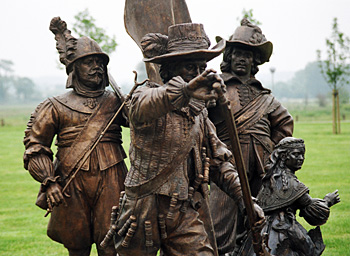| |
NIGHTWATCH 3D
Who would expect the famous fusiliers from
the squadron commanded by Captain Frans Banning Cocq, as portrayed
in 1642 by Rembrandt, to leave the canvas and to become a
three dimensional bronze sculpture? But this time, not in
the seventeenth century but in the twenty first century Holland.
The concept of this thoroughly unique project
was conceived by two Russian sculptors – Mikhail Dronov and
Alexander Taratynov. The history of art has known nothing
of the kind to date. The sculptors have created something
fundamental and professional. They have modelled, sculpted
and cast in bronze the figures of the 22 fusiliers; their
exuberant outfits, arms, and various accessories. They, as
it were, threw down the gauntlet to, everyday perceptions
of the famous “Nightwatch” painting.
So, at first you feel surprised and perplexed
while getting acquainted with the Russian sculptors’ materialized
idea; what on earth have they done it for? And this issue
can be considered from several angles.
The first point of view: M. Dronov and A.Taratynov
tried to breathe new life into the legendary classical work
of art. “Rembrandt, the martyr of light-and-shade” (O.Mandelstam),
solved problems of interaction of his characters on the flat
surface of the canvas. Now, organizers of potential exhibitions
may illuminate or put the Dutch fusiliers ‘in the shade’ in
many different variations, creating a historical or modern
background for them. Rembrandt’s characters are sculpted in
the traditional realistic manner of the academic Russian school.
Western Europe has already forgotten this school, commending
itself completely to “high-brow” art-criticism scholastics
lapsing into the newest fashionable tendencies.
The second point is that of a spectator.
The purpose of the transition into bronze is to “give the
spectator an opportunity to feel as if they are inside a painting”
(A.Taratynov). Entering, playing, taking pictures, shooting
videos of their relatives with the “Nightwatch” characters,
and performing a kind of “spectators’ happening”. For children
and adults this is ‘literally’ an act of getting inside of
art. After this game interaction, the next meeting with the
painting will be definitely perceived in a new way. A journey
through the sculpture’s “looking glass” and back, to the Rijksmuseum
halls, is a wonderful cognitive route from the twenty first
century to the seventeenth century, back again.
From commercial and promotional point of
view, this project by Dronov and Taratynov is absolutely unique.
It’s no wonder the sculptors had their idea registered with
the Russian copyright bureau and its counterpart in Washington
D.C. Their project is a real museum godsend in many ways.
This object should increase museum attendance, promoting the
creative work of Rembrandt’s masterpiece, an event of news
media proportion, and another reason to print postcards, brochures,
calendars, posters, etc.
The “Nightwatch 3D” project is an innovation
in the continuation of the original museum piece’s life. The
fact that it is realized in the method of time-tested realistic
sculpture does not, in any way, belittle its innovative importance.
William Mailand
September 2004, Moscow
|
|



|